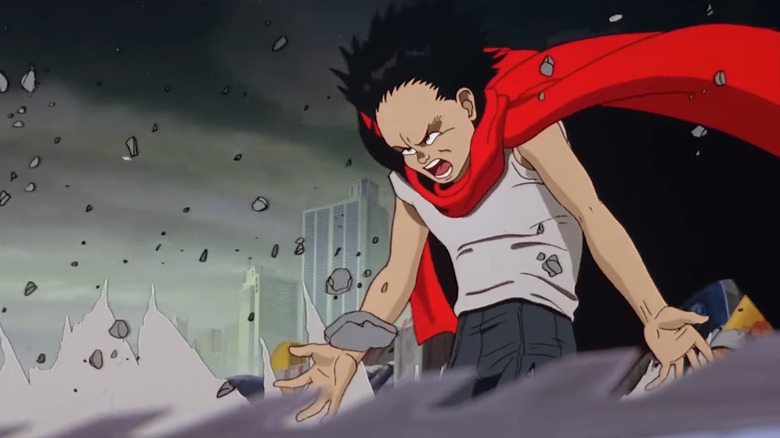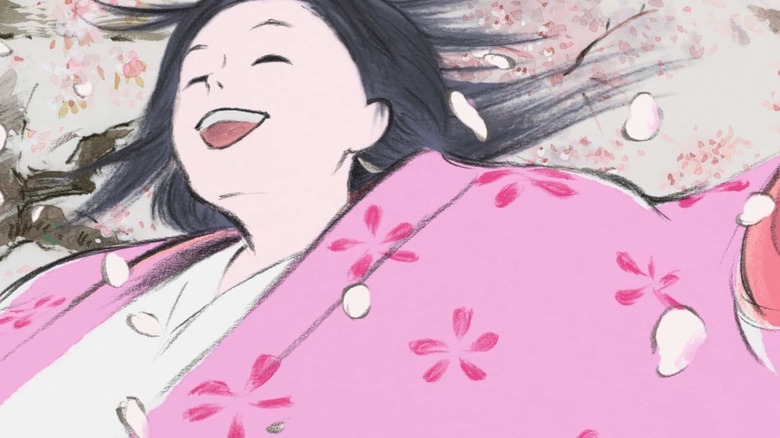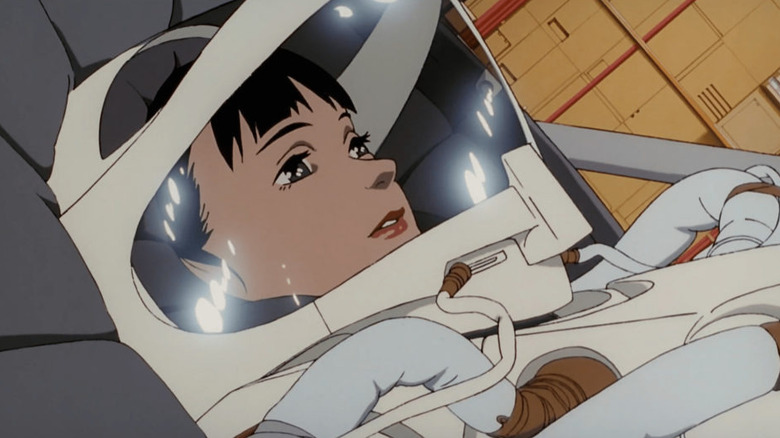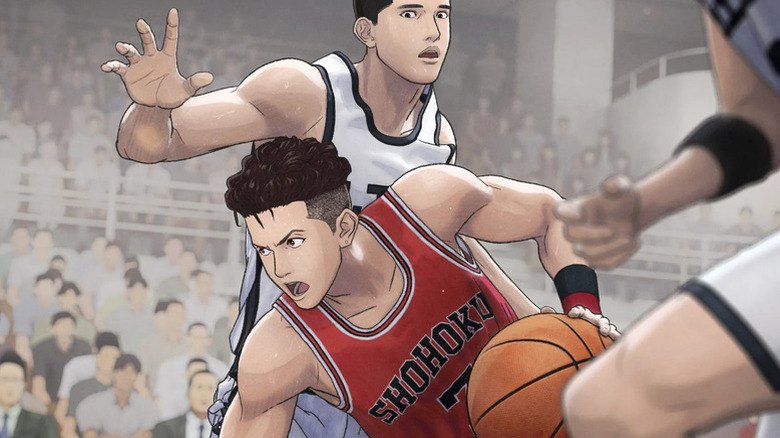5 Essential Anime Movies Everyone Should Watch At Least Once
The medium of animation is extremely vast and versatile. Even if you narrow it down to just anime (animation produced in Japan), there are so many different genres and tones that making any sort of comprehensive list is a near-impossible task (but you better believe we've tried). Despite what some Academy members may think, anime is much more than movies for kids, and much more than just "Dragon Ball," even if that particular show has come to define action-adventure anime for the last 40 years. Shonen shows and movies (like "Dragon Ball") cater to an entirely different demographic than, say, "A Silent Voice," which is also a very different demographic and tone from "My Neighbor Totoro."
We can at the very least get you started with some essentials if you have never stepped into the exciting world of anime. We already covered five essential anime TV shows everyone should try, so it's time we do the same with feature films. Before we proceed, it seems sensible to add a couple of special mentions that simply didn't fit this list, starting with the work of master filmmaker Hayao Miyazaki.
You won't find a Miyazaki movie here, for a couple of reasons. First, his work is just so known and recognized around the world (even by non-anime fans) that to add any of his movies, even the best ones, would be akin to telling someone new to animation to watch a Disney movie. Sure, they probably should do that, but they already know that. (That being said, Miyazaki's "Princess Mononoke" is a movie everyone should watch, an incredible work of animation with complex characters and themes, and a stunning look at the struggle between nature and progress. It's one of the best dark fantasy movies of all time.)
Though not as acclaimed and without the same level of reputation, Makoto Shinkai's "Your Name" is nevertheless a movie that's also a very easy recommendation for folks getting started on the medium. It's a showcase of what modern anime can do, a popcorn teenage romance movie with simply incredible visuals and a great soundtrack.
Finally, "Look Back" is a masterpiece of animation, a mid-length feature based on a story by the creator of "Chainsaw Man" about the cost of art and the joy of making it, as well as friendship and creativity. It's also one hell of a tear-jerker, so keep that in mind.
With the caveats out of the way, let's look at five essential anime movies everyone should watch at least once.
The End of Evangelion
This is the one and only movie on this list that is based on a television show, but regardless of your level of familiarity with "Neon Genesis Evangelion," nothing can prepare you for "The End of Evangelion." Hideaki Anno's masterpiece, and the final chapter in the story (for a time, anyway), is a monumental piece of filmmaking. It's a highly controversial and personal story that feels like a creator speaking directly to its audience.
A big part of what makes this such an essential work is that "The End of Evangelion" is both a sci-fi epic and a deeply experimental piece of animation. The movie delivers the big-budget, large-scope theatrical spectacle that fans of the TV show hoped for but never got (the series went hugely over budget and changed perspectives to become quite introspective and focused more on psychology than big fights). Just take the fight between Asuka and the Mass Production Evangelions, a thrilling, nerve-wracking action sequence we've ranked among the best in all of anime. It's an absolute marvel to watch. The movements are so realistic you could mistake them for rotoscoping, with every movement having incredible weight to it and exquisite attention to detail paid not just to the guts and blood that cover the screen, but also the tiny mechanical pieces that surround the fighting juggernauts.
Then there's the climax of the film, the singular work of a creator lashing out against the negative reaction to the ending of the series. Rather than cave in to fan demand like cowardly Hollywood studios, he doubles down and makes the most aggressively weird movie of the '90s (which is saying something), breaking down the fourth wall and holding a mirror to the very audience watching it. The Third Impact sequence is one of the most horrifying, mesmerizing things ever animated, a look at the end of the world accompanied by a hauntingly beautiful pop song about depression and suicide. It's an incredibly complex movie that's borderline inaccessible without diving into supplemental material or online theories and explainers (like this one).
And yet, "The End of Evangelion" is also a rather life-affirming movie about embracing the joy and pains of human existence. It's a singular creative vision unlike any other, and an essential piece of animation.
Akira
What can be said about "Akira" that hasn't already been said in the last 37 years? Katsuhiro Ôtomo's adaptation of his own manga series is a cornerstone of the cyberpunk genre, a staple of anime, and simply a cinematic masterpiece.
As a story, "Akira" is as groundbreaking as the likes of "Blade Runner." It introduces a fully-realized world that's beyond messed up — one fundamentally broken and filled with protests, riots, and unrest. In the middle of all this lies a deceptively simple story of a teenage bike gang that's torn apart when one of their own accidentally gains telepathic abilities and is kidnapped by clandestine military government agents.
Ôtomo's ability to balance the personal arc of childhood friends and rivals Kaneda and Tetsuo with the larger story of the socio-political upheaval in Neo-Tokyo and a government desperate to hide the past while repeating it is unparalleled. This is the kind of movie you can watch multiple times and still find new layers to the story (which is based on roughly half of Ôtomo's 2000-page manga epic), and also new layers to the visuals.
As impressive as the story of "Akira" is, it is indubitably overshadowed by the singular towering achievement that is the movie's animation. This groundbreaking, once-in-a-lifetime production tagged virtually every single animation and animation house in Japan to help bring Neo-Tokyo to life. There was never a movie like "Akira" before it, and there will never be another. This is a true marvel of light and color, and a movie that quite literally invented new shades of colors in its creation of the megacity that is Neo-Tokyo, a bustling metropolis with a pure maximalist aesthetic whose ominous presence is seen or felt in every single frame, with skyscrapers on top of skyscrapers. Whether your favorite moment is the famous "Akira Slide" that's been recreated in countless animated titles (and even in live-action in Jordan Peele's "Nope") or the body horror of Tetsuo's transformation, this is a monumental piece of animation that is essential to understand the power of the medium.
The Tale of the Princess Kaguya
"The Tale of the Princess Kaguya" is one of only four perfect anime movies, according to Rotten Tomatoes. Though Hayao Miyazaki is the name most people associate with Studio Ghibli, it's Isao Takahata's work that truly showcases the power of the studio. His work runs much emotionally deeper and visually more experimental than Miyazaki's, and it is most evident in "The Tale of Princess Kaguya," his last film before passing away.
An elegiac adaptation of a classic Japanese fairy tale, "The Tale of Princess Kaguya" follows an old bamboo cutter who discovers a tiny princess blossoming from a bamboo shoot. When the baby starts having sudden growth bursts the cutter and his wife take her to the capital to live in a mansion so she can live as the princess they know she's destined to be. Except, the princess desperately misses the freedom she used to have on the open fields by the mountain. This is a heartbreaking yet beautiful exploration of the fleeting nature of childhood, an intimate story that's also a domestic epic that encompasses entire lifetimes in a single film. A cage is still a cage, no matter how it's decorated, and you feel that constriction just as Kaguya does, with Takahata delivering a movie full of tragedy that is not without moments of fantasy and pure joy.
Visually, this movie is absolutely stunning. An impressionistic homage to Japanese folklore and woodblock prints, the movie employs minimalistic watercolor backgrounds and incredibly fluent motion to showcase the strength and resolve of its titular character. The sequence of Kaguya running through the palace is, simply put, unlike anything else Ghibli has ever done — and that sequence alone should have given this movie an Oscar.
Millennium Actress
Satoshi Kon was one of the most brilliant creative minds in modern animation. Though he only directed four feature films (and one mesmerizing TV show) before his tragic death, Kon left an indelible mark on the medium, with his work being so influential it's been all but copied by Western filmmakers over and over (yes, this is about Aronofsky, but also Nolan). Though "Perfect Blue" is arguably his most popular film, I'd argue the more distinct and essential work is Kon's sophomore feature, "Millennium Actress."
The plot follows two documentary filmmakers investigating the life of retired actress Chiyoko Fujiwara, who tells them her life story. Like with the rest of his work, Kon blurs the line between reality and fiction, with the documentaries themselves becoming participants in Fujiwara's life as they find themselves in the middle of her movies and it becomes less clear what is a memory and what is a scene from a movie. This is Kon's most romantic film by far, not only because of the story of Fujiwara's eternal search for the love of her life she met as a teenager, but because of how Kon captures the power of cinema to create empathy and connections, and to romanticize life in general.
This movie is also a stunning love letter to Japanese cinema history, with Kon and the animation team at Madhouse delivering a hand-drawn, cel-animated movie that recreates the look and feel of Japanese movies from the '40s to the '70s. Whether you're intimately familiar with the history of cinema or just getting into Japanese film, "Millennium Actress" is a perfect film studies class, with references to everything from Kurosawa to tokusatsu movies like "Godzilla" and beyond. It's no wonder the unique blend of romantic drama and fantasy influenced even The Daniels in "Everything Everywhere All At Once."
The First Slam Dunk
This is the newest movie on this list, but it is every bit as deserving to be here as the others. "The First Slam Dunk" is an achievement in modern animation. Much like "Akira," it sees a manga creator adapt his own work to the big screen and take huge creative liberties that result in a unique visual experience. Takehiko Inoue's "Slam Dunk" manga was hugely popular and influential in the '90s, but the anime of the same name ended before adapting the final story arc. Now, Inoue takes matters into his own hands by writing and directing the feature film version of his own story.
Given that it had been decades since the original story, and given the change in medium, the movie couldn't simply be a continuation of the anime. Instead, Inoue remixes and rearranges the story, which takes place during a single basketball match between Shohoku High and Sannoh Kyogo High, with original flashbacks exploring each team member's past and their motivations. The film changes protagonists from the manga and anime, which keeps the story fresh and makes it more accessible for newcomers. This is the perfect introduction to "Slam Dunk," as well as its perfect conclusion.
As a sports film, this is pure, exhilarating spectacle, with Inoue displaying a keen eye for dynamic action and kinetic movement despite being a first time director. The film captures the high-octane rush of a basketball game with ease, with the camera pulling impossible angles and movements that showcase the power of animation in placing you amid the action. From POV shots from the characters' perspectives to the camera flying through the court and swirling through defenses like another player, this is another stunningly animated entry on this list. It helps that Inoue employs a mix of 2D and 3D animation that does for anime what "Into the Spider-Verse" did for Western animation in showing a new way of portraying 3D action, with movements so fluid they feel rotoscoped, while remaining expressive enough to be unequivocally animated.
"The First Slam Dunk" captures what makes basketball so thrilling while showing why animation is such a unique medium. If you're looking to explore anime movies, give it a shot. (Pun intended.)





